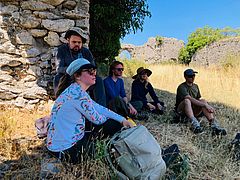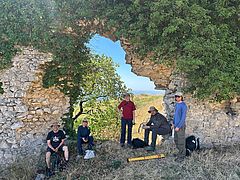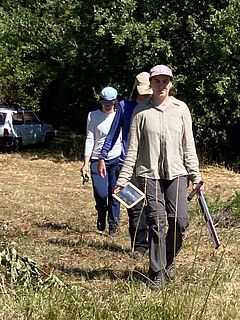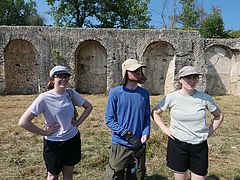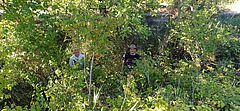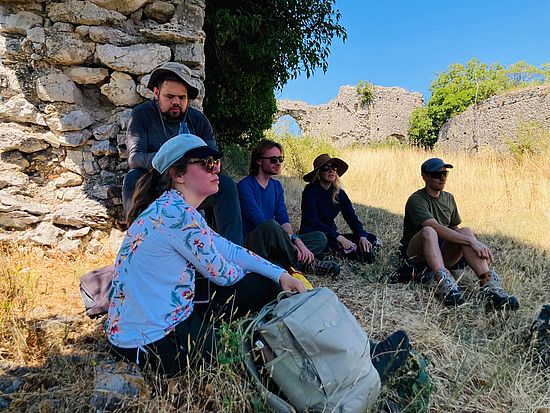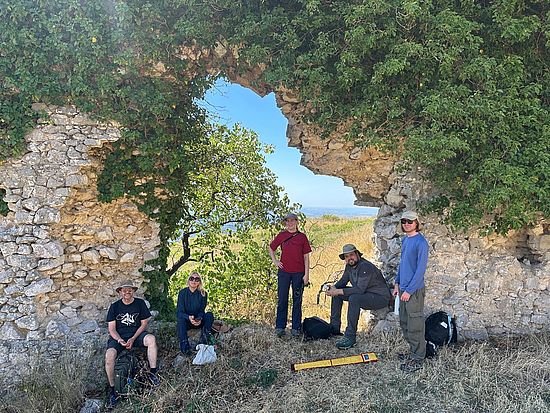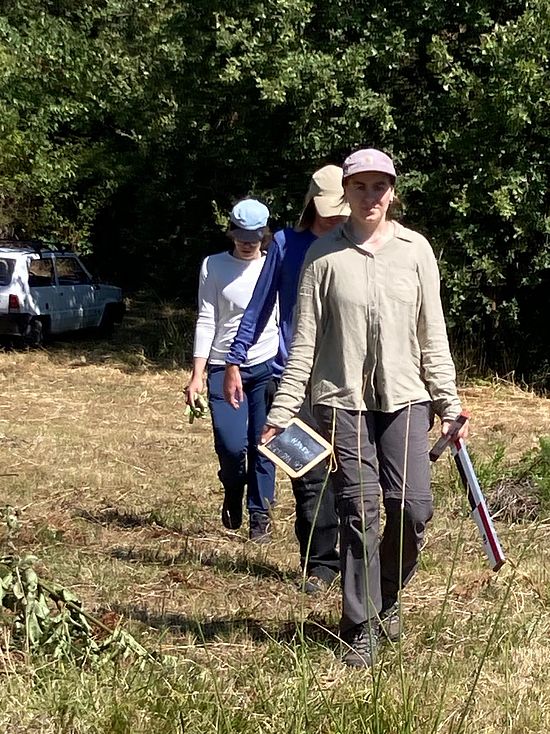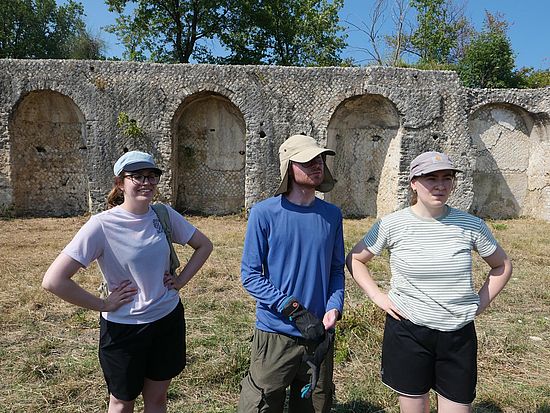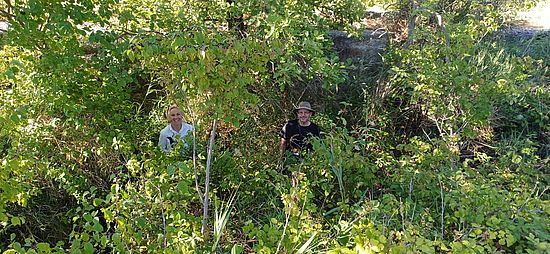The Team
The Villa dei Casoni Research Project is led by an interdisciplinary team of historians and archaeologists specializing in the study of Roman rural economies, environmental change, and settlement history. The project brings together expertise in ancient history, archaeology, environmental science, and digital methods to investigate the long-term interaction between human societies and their landscapes in central Italy.
Prof. Dr. Sabine R. Huebner – Scientific Director Prof. Dr. Sabine R. Huebner is a historian of the ancient world and the principal investigator of the Villa dei Casoni Research Project. As Professor of Ancient History at the University of Basel, she specializes in the social, economic, and environmental history of the Roman Empire, with a particular focus on climate, disease, and rural economies. She has led multiple interdisciplinary projects that bridge historical research with scientific approaches, advancing the study of human-environment interactions in antiquity. She oversees the project’s historical framework, the integration of historical, epigraphic, archaeological and paleoenvironmental data, and the broader contextualization of the villa within the socio-economic and agricultural history of the Roman world.
Dr. Stefania Alfarano – Archaeological Director Dr. Stefania Alfarano is an expert in classical and late antique archaeology, with extensive experience in fieldwork across Italy and Egypt. Currently a lecturer at University College London, she has led numerous excavations and archaeological surveys focusing on rural settlement patterns, landscape transformation, and architectural history. As the archaeological director of the project, she is responsible for fieldwork planning, survey execution, GIS-based mapping, and the architectural and spatial analysis of the site.
Simon Bühler, MA - Field Director Simon Bühler studied Art History and Classical Archaeology (BA) at the University of Basel and earned an MPhil in Classical Art and Archaeology from Christ’s College, University of Cambridge, where he completed his degree with distinction. His master's research focused on the role of sculptural interaction in Classical Greek art of the 5th century BCE. At the University of Basel, Bühler worked as a research assistant in Classical Archaeology and Art History. Since 2022, he has been a doctoral candidate in Ancient History and a member of the eikones graduate program. As field director, he oversees the material laboratory and archaeological operations, contributing his expertise in visual culture and site analysis to the broader investigation of the Sabina Tiberina region.
Laura Cerri - geophysical prospection Laura Cerri is an expert in archaeological geophysics, specializing in magnetometry and non-invasive survey methods. She holds a degree in Classical Archaeology from the University of Siena (1999, summa cum laude) and a PhD (Doctor Europaeus, 2006) on trade and production in Mauretania Tingitana. She has taught courses on Roman archaeology, ceramic analysis, and geophysical prospection at the University of Siena and has contributed to numerous international excavation and survey projects across Italy, North Africa, and the Mediterranean. As the geophysical prospection specialist for the Villa dei Casoni project, Laura applies advanced techniques to detect and map buried structures. Using fluxgate gradiometers, she identifies subsurface anomalies, such as walls, kilns, and roads, helping to refine excavation strategies and maximize archaeological insights.
Prof. Dr. Stephan Korom – Field Photographer Stephan Korom is a highly accomplished medical researcher and surgeon with a strong passion for ancient history. He has over 25 years of experience in clinical practice, academic teaching, and medical research. A faculty member at the Department of Surgery, Justus Liebig University Giessen, and a former physician/researcher at Universitätsspital Zürich, Stephan has worked extensively in general & trauma surgery and respiratory medicine (thoracic surgery, lung transplantation). His career also includes leadership roles in the pharmaceutical industry in clinical development and medical affairs, particularly in infectious diseases and immunology. As field photographer for the Villa di Casoni project, he captures the site's excavation process, material culture, and landscape, ensuring high-quality visual records for research and analysis.
Andrea Giusti – Site Maintenance and Field Support Andrea Giusti, based in Torri in Sabina, cares for the landscape of the Villa dei Casoni. Under the direction of the project’s archaeologists, he has been responsible for clearing the dense vegetation that covered much of the site, in particular extensive blackberry thickets reaching up to four meters in height. His careful work in opening the terrain has been essential for archaeological access and has already led to the discovery of several important features during the first season. By maintaining and preparing the site, he plays a vital role in enabling the systematic exploration and study of the villa complex.
Prof. Dr. Holger Thünemann – Historical Didactics and Public History Prof. Dr. Holger Thünemann is Professor of History Education at the University of Münster, specializing in historical culture, memory, and the public uses of history. His research explores the ways in which history is taught, represented, and communicated in schools and universities and the public sphere, with particular attention to questions of memory, identity, and the uses of the past. He brings to the Villa dei Casoni Research Project his expertise in historical didactics and public history, developing strategies to communicate the project’s findings to wider audiences. His role centers on integrating the villa’s social, economic, and environmental history into educational contexts and on shaping outreach formats that connect the site’s past to contemporary questions of cultural memory.
Student Researchers
The project is supported by a team of graduate students from the University of Basel’s Institute for Ancient History, including Lena Steffen, Gianna Chiara Danz, Bernhard Krieter, and Cédric Brechbühler. Their academic backgrounds span ancient history, classical archaeology, Roman economic and social history, and environmental history. Together, they contribute to different aspects of the research, including archaeological survey, paleoenvironmental analysis, historical interpretation, and the study of agricultural change in central Italy. Their work is central to reconstructing the long-term economic and ecological dynamics of Villa dei Casoni. This collaborative team brings together historical, archaeological, and scientific perspectives, ensuring a comprehensive approach to studying the relationship between land use, climate change, and agricultural transformation in the Roman world.
